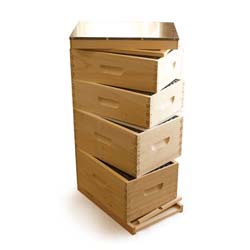Winter transforms a beehive in remarkable ways. While the outside world grows cold and quiet, honey bees inside the hive shift into a survival mode that has evolved over millions of years. Understanding what happens inside that wooden box during the coldest months helps beekeepers support their colonies more effectively.
The Winter Cluster Forms
When temperatures consistently drop below about 50°F (10°C), honey bees begin forming what’s called the winter cluster. This isn’t a random gathering—it’s a precisely organized survival strategy. Bees pack tightly together into a ball-shaped mass, typically at the warmest part of the hive (which is usually the middle to upper portion since heat rises) where they’ll have access to stored honey above and around them.
The cluster has two distinct zones. The outer shell consists of bees packed tightly together, creating an insulating layer that can be several bees thick. These bees are nearly motionless, conserving energy while protecting the colony’s core. Inside this shell, the cluster’s center stays surprisingly warm—often between 77-97°F (25-36°C)—even when outside temperatures plummet well below freezing.
How Bees Generate Heat
Honey bees don’t simply huddle for warmth. They actively generate heat through a fascinating process called thermogenesis. Bees in the cluster’s core vibrate their flight muscles without actually flying, creating metabolic heat much like shivering generates warmth in mammals. This constant, subtle vibration keeps the cluster’s center at temperatures suitable for survival.
The bees don’t stay in the same positions throughout winter. Those on the cold outer shell rotate inward to warm up and feed, while warmer bees from the center move outward. This rotation ensures no bee gets too cold for too long, and it keeps the colony functioning as a cohesive unit throughout winter’s duration.
Movement Within the Hive
The winter cluster isn’t stationary. As the bees consume honey stores near them, the entire cluster slowly moves upward and across the frames to access more food. This movement is gradual—sometimes just inches per week—but it’s essential for survival. A cluster can starve to death just inches away from abundant honey stores if extremely cold weather prevents them from moving to reach it.
On warmer winter days (above 45-50°F or 7-10°C), the cluster loosens somewhat. Bees become more active, and the cluster can shift position more easily to access food stores. In mild winter climates, bees may even break cluster entirely on warm days, allowing for cleansing flights and more substantial hive activity.
The Broodless Period
One of winter’s most significant changes is the absence of brood. Unlike spring and summer when the queen lays thousands of eggs daily, most colonies experience a “broodless period” during the coldest winter months. The queen stops or dramatically reduces egg-laying, which means the colony doesn’t need to maintain the higher temperatures required for developing brood.
This broodless period is actually beneficial—it conserves food stores and gives the colony a break from the demanding work of raising young. As days begin lengthening in late winter (often as early as January or February, depending on location), the queen gradually resumes laying, and the colony starts preparing for spring.
What Normal Winter Activity Looks Like
From the outside, a healthy winter colony appears quiet, even dormant. Beekeepers might see a few dead bees at the hive entrance—this is normal winter cleanup. On warmer days, they might observe cleansing flights, where bees emerge briefly to eliminate waste they’ve been holding during colder periods. There’s also the need for water foraging – which the bees do on warmer days since water is a resource that can’t be stored but is still needed and very important.
Inside, the colony maintains its cluster, slowly consuming stores, rotating positions, and waiting patiently for spring’s return. It’s a period of remarkable endurance, showcasing the honey bee’s incredible adaptations for survival in challenging conditions.
